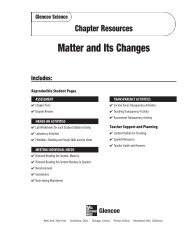chap06 - Learning Services Home
chap06 - Learning Services Home
chap06 - Learning Services Home
- No tags were found...
Create successful ePaper yourself
Turn your PDF publications into a flip-book with our unique Google optimized e-Paper software.
Figure 19 The furnace’s fanhelps circulate hot air through yourhome. Warmer air particles moveupward while cooler air particlesmove downward.Explain why the hot air ducts areplaced near the floor.Hot airCold airExhaustAir ductFurnaceFanComparing EnergyContentProcedure1. Pour equal amounts ofhot, cold, and roomtemperaturewater intoeach of three transparent,labeled containers.2. Measure and record thetemperature of the waterin each container.3. Use a dropper to gentlyput a drop of food coloringin the center of eachcontainer.4. After 2 min, observe eachcontainer.Analysis1. Based on the speed atwhich the food coloringspreads through the water,rank the containers fromfastest to slowest.2. Infer how water temperatureaffected the movementof the food coloring.3. In which container do thewater particles have themost kinetic energy?Feeling the Heat Think about getting into a car that hasbeen closed up on a sunny day. Do you prefer a car that hasfabric-covered or vinyl-covered seats? Even though the massesof the seats are similar and the temperatures of the surroundingsare the same, the vinyl material feels hotter on your skinthan the fabric does. How hot something feels also is affected byhow fast heat flows, as well as the actual temperature. Vinyl is abetter conductor than fabric, so heat flows to your skin morerapidly from the vinyl than from the fabric. As a result, the vinylfeels hotter than the fabric does.Convection Heat also can be transferred by particles that donot stay in one place but rather move from one place to another.Convection (kun VEK shun) transfers heat when particles movebetween objects or areas that differ in temperature. This type oftransfer is most common in gases and liquids. As temperatureincreases, particles move around more quickly, and the distancebetween particles increases. This causes density to decrease astemperature increases. Cooler, denser material then forces thewarmer, less dense material to move upward.Some homes are heated by convection. Look at Figure 19.Air is warmed in the furnace. The warm, less dense air is thenforced up through the air duct by the furnace fan. The warm airgets pushed up through the room by the cooler air around it. Asthe warm air cools, it becomes more dense. Cool, dense air sinksand is then pulled into the return air duct by the furnace fan tobe warmed again and recirculated.176 CHAPTER 6 Energy














